-
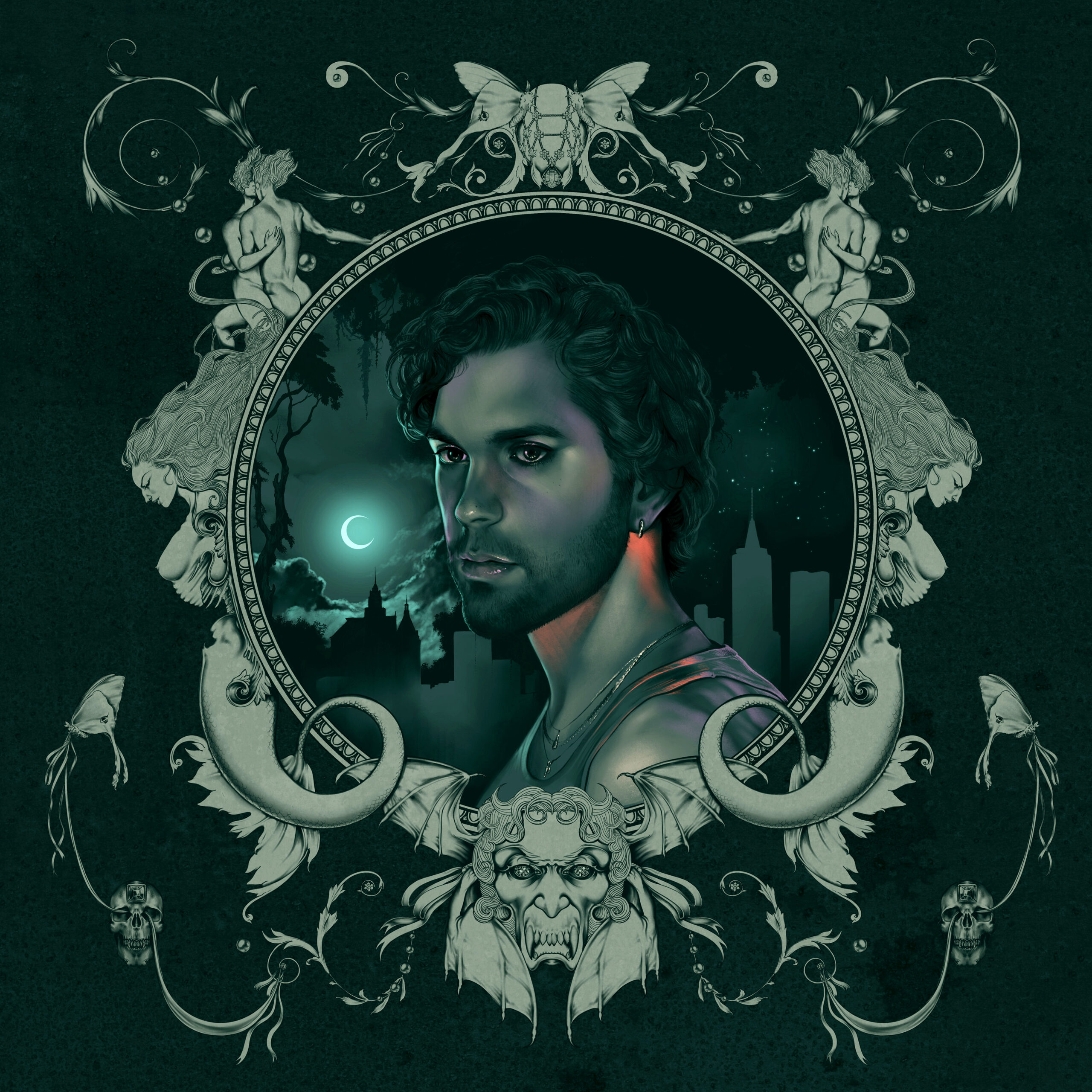
2023 self portrait by Colin Verdi
Interview by Greg Kozatek
Copy edited by Nora MacLeod -
This interview has been edited for length and clarity.
What did you study as an undergrad?
My major was East Asian studies. I studied Chinese language and minored in business. I did the liberal arts undergrad thing because when I was 18, people in my life told me that pursuing art was a limiting decision, and that if I wanted to study art later, it would always be there. They said it would be harder to go to art school and then try to get a corporate job. Now, at 31, I don’t know if all those people were right, but at 18, I didn’t know any better, and it was scary.
Where did you go to grad school and what brought you there?
I went to the School of Visual Arts here in New York where I got my MFA in illustration. I graduated in 2018.
I don’t know what expectations I had. I’d done some small illustration-y jobs before getting a MFA, but I didn’t understand what I was getting myself into. I always liked to draw and was drawn to book covers and fantasy artwork and history paintings, specifically those centered around mythology. Growing up, my teachers would tell me, “This stuff that you’re making looks like illustration. You should look into that.” But the other adults in my life told me not to do art as a career because it’s “hard.” That’s all they ever said, “hard,” but I didn’t know what that meant
After undergrad, I spent a year applying to corporate jobs. At some point in every interview that I went on, the interviewer would look at me and say something like, “I just feel like you’d be happier doing something more creative,” and I wouldn’t get the job. I felt aimless and ashamed of failing in a very early-2010s-millenial-college-grad way, and that was already “hard,” so I decided to just give in to that impulse to pursue art as a career. One of my first illustration jobs was for Into the Gloss, because I had a friend who wrote for them and she was hired to write an article about Babeland, and she got me hired to tag along and make an illustrated map of the store to accompany the article. It was fun but I could already tell I had a lot to learn if I wanted to make it a “real” job. Funnily enough, later, when I was in grad school, I worked on the weekends at Babeland where I was a sex educator/sales associate. I was a pretty bad employee, spending half the time drawing during my shift, but after I graduated they hired me to produce illustrations that they could use as social media content. Some of my work ended up as banners in the store windows, which was one of my first experiences seeing my work out in the world in a different context. It was a full circle moment where Babeland was the subject of my first “real” paid illustration job, and then the first ones after grad school, too. Also, I loved that job and it felt rewarding to stay involved with the people there. Everyone that I worked with was queer and I felt solidarity with my coworkers.
-
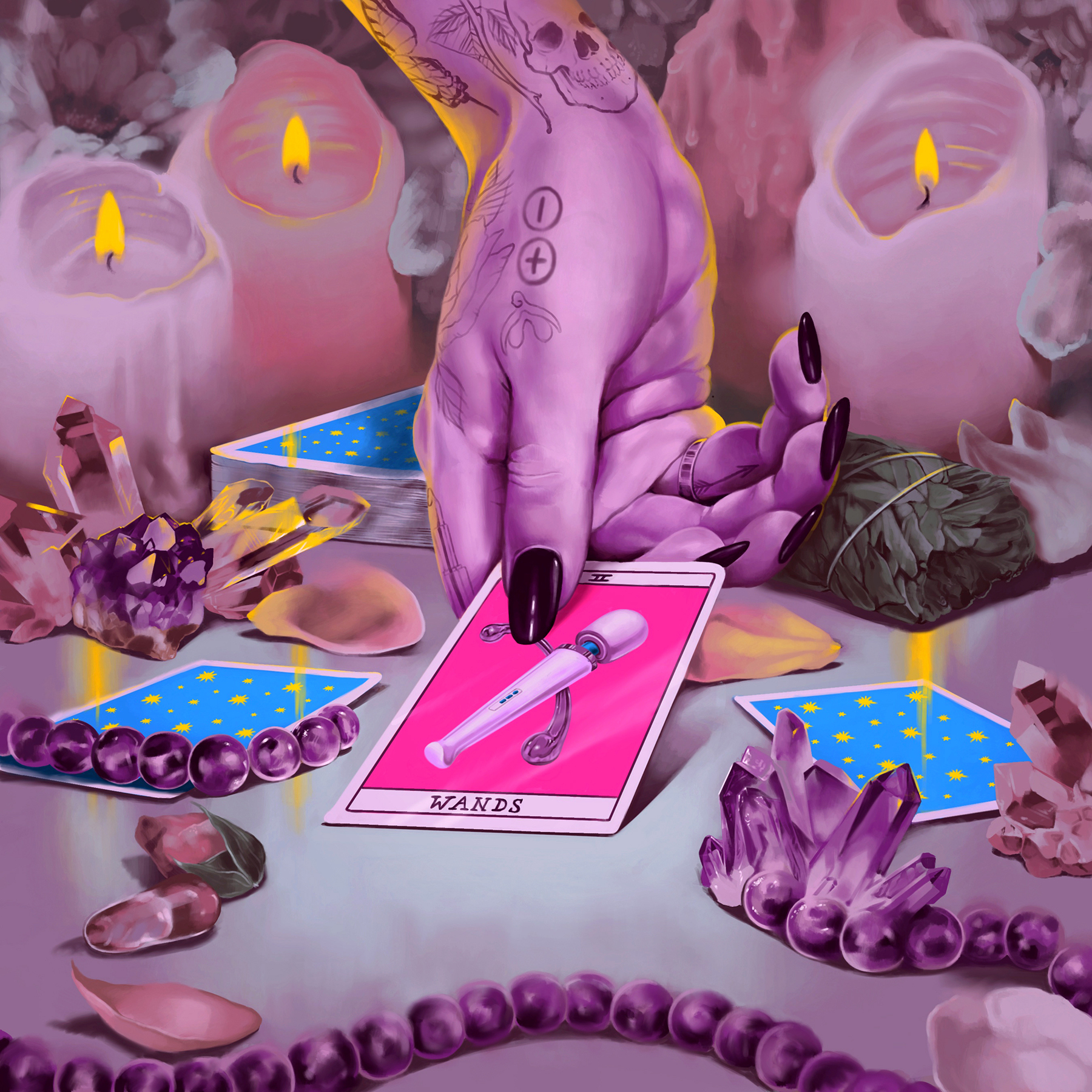
Illustration for Babeland
-
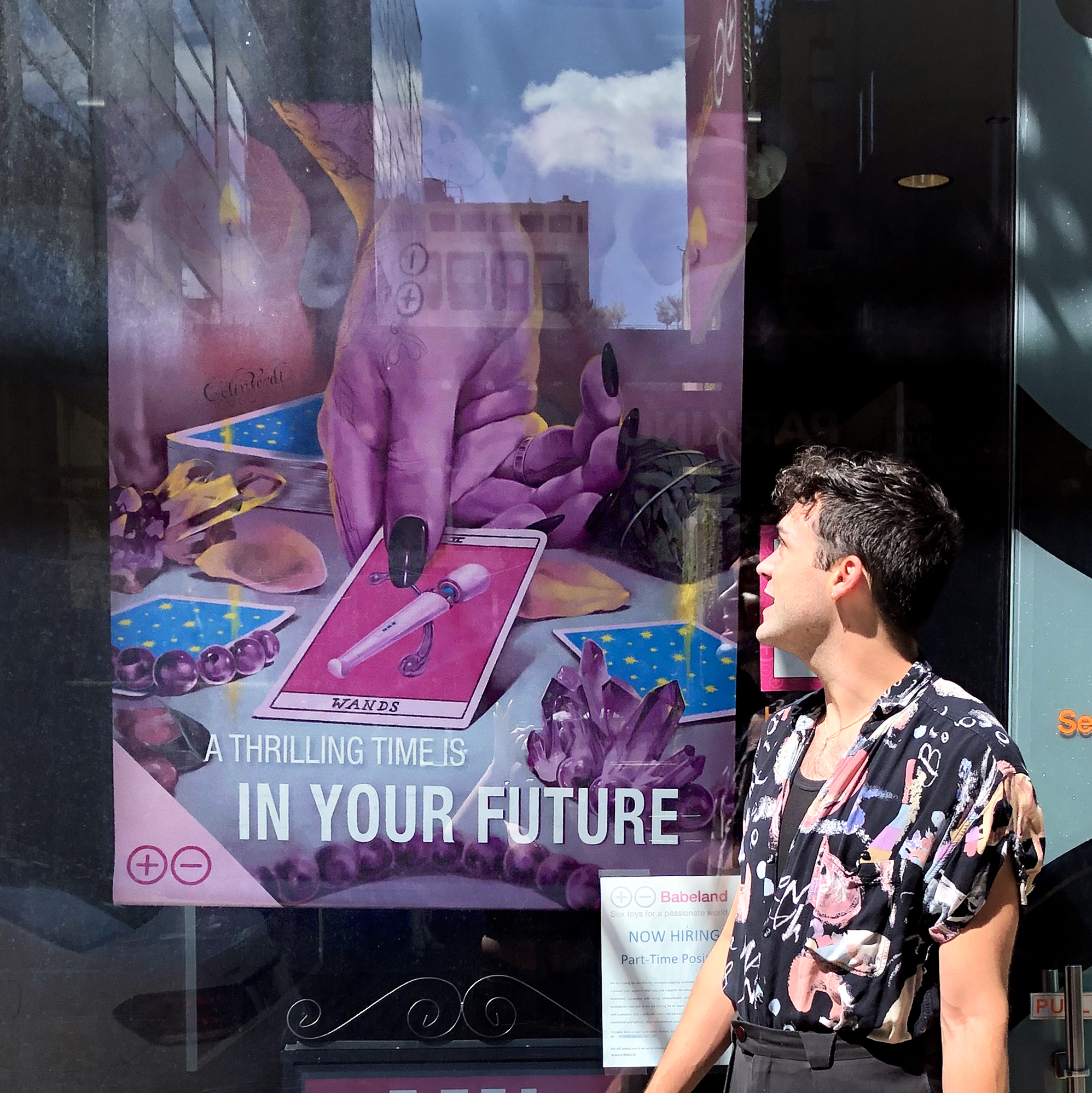
Colin seeing his Babeland poster out in the world
-
Looking back do you feel as though illustration is a “hard” career path?
I think it’s hard in the way that it can be uneven. I feel very lucky that for the past two years work has been consistent, but it ebbs and flows. If you have a month where you’re not getting emails about new projects, it can feel like, “What am I gonna do?” It’s hard to switch off that part of your brain that panics.
Have you had months where nothing has come in?
Yes. But, it’s very “When it rains, it pours.” There’s maybe two months where I’m trying to juggle five projects and then a month where it’s crickets and I try to remind myself: “Two months from now you’re going to be overwhelmed, and you should take this time to rest and try to not let yourself get burnt out.”
Do you have advice for getting through the drier times?
I would say, save up more money than you think you need, because you might have to go three months where even if you’ve been doing work, you’re pestering someone to fulfill an overdue invoice from the last job. I think it’s just being sort of practical and living almost beneath your means a bit.
-
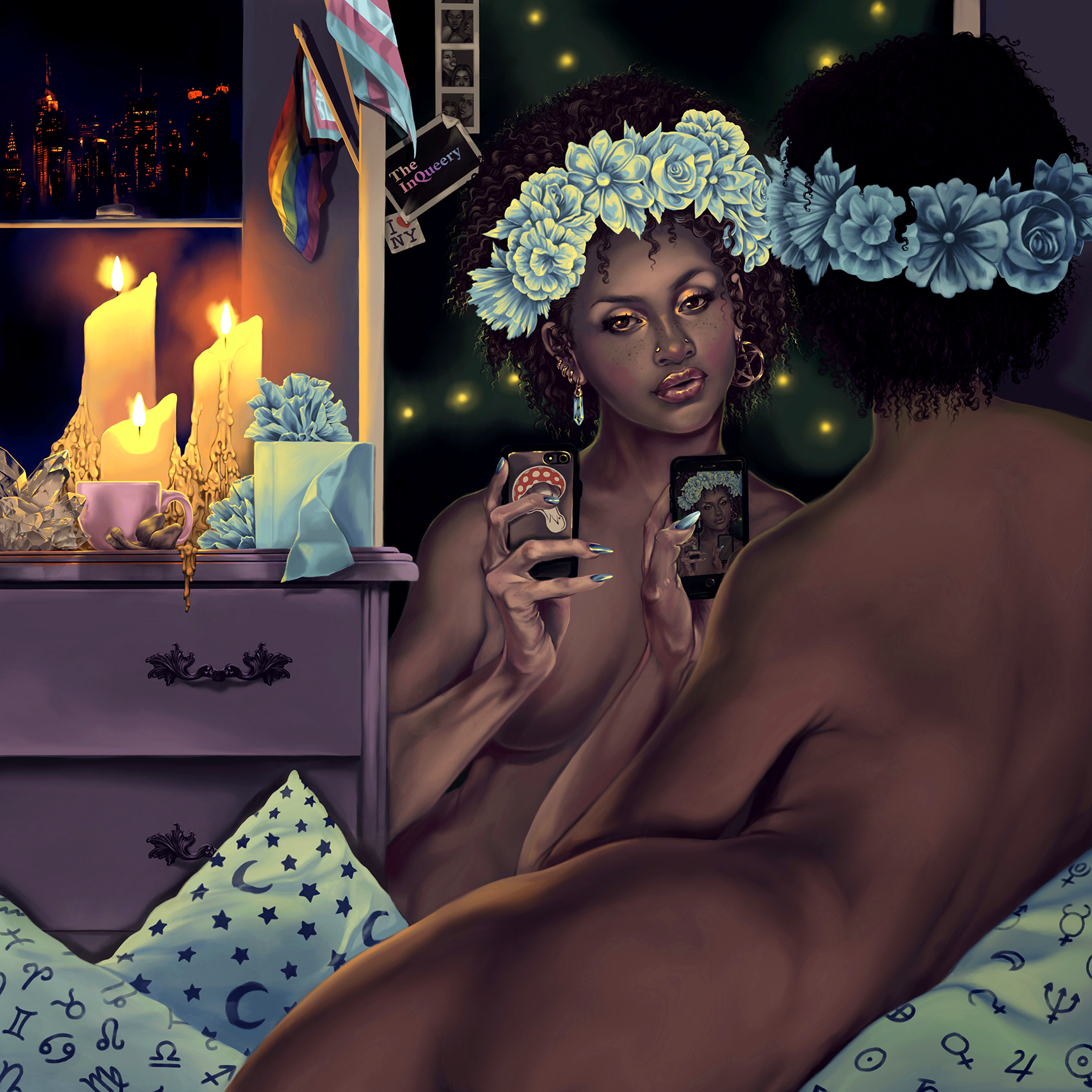
InQueery Illustration for Gay Day May Day
-
What kinds of projects are you most drawn towards?
Book covers suit me on a lot of different levels. The deadlines are generally longer than editorial, which is nice because my work is more painterly and takes time. Book projects also have a built-in narrative, which gives me more to play with than a page of text. And it’s so gratifying to see them out in the world, you’re basically making a tiny little billboard that would make someone scanning a shelf stop and say, “Ooh, that one!”
Starting off, were you getting different types of jobs?
When I was in grad school, they encouraged us to do editorial work so I started off trying to get that type of work, and I have done some. I learned how to make art quickly, but I don’t know how well my work is suited to editorial. I think a lot of the art directors are looking for work that is more conceptually driven. It’s not that I think I don’t have concepts or don’t think that I’m clever in the same way that editorial illustrators are, but I’m maybe more interested in execution, or something?
I’m curious to know more about your first book project.
I had it in my head that I wanted to work on books, but wasn’t getting any bites on my promotional emails. So I went to Barnes & Noble and took pictures of every book cover that made me have this feeling of, “I could have done that.” I went home and made a piece that I felt could sit alongside them, while still feeling like “me.” I sent that around and then maybe like six months after, an amazing art director at Macmillan, Olga Grlic, emailed me back and asked me to tailor it with some details for a book she was working on.
What was the name of the book?
The Death of Jane Lawrence. It’s a gothic horror in the same realm as Rebecca or Crimson Peak. When it came out, Barnes & Noble picked it for a monthly promotion and asked me if they could use the illustration on all of the signage featured in every one of their stores. They even agreed to print my name on the signs! That was very exciting, especially for the first “big” one, and it hasn’t happened again (yet).
-
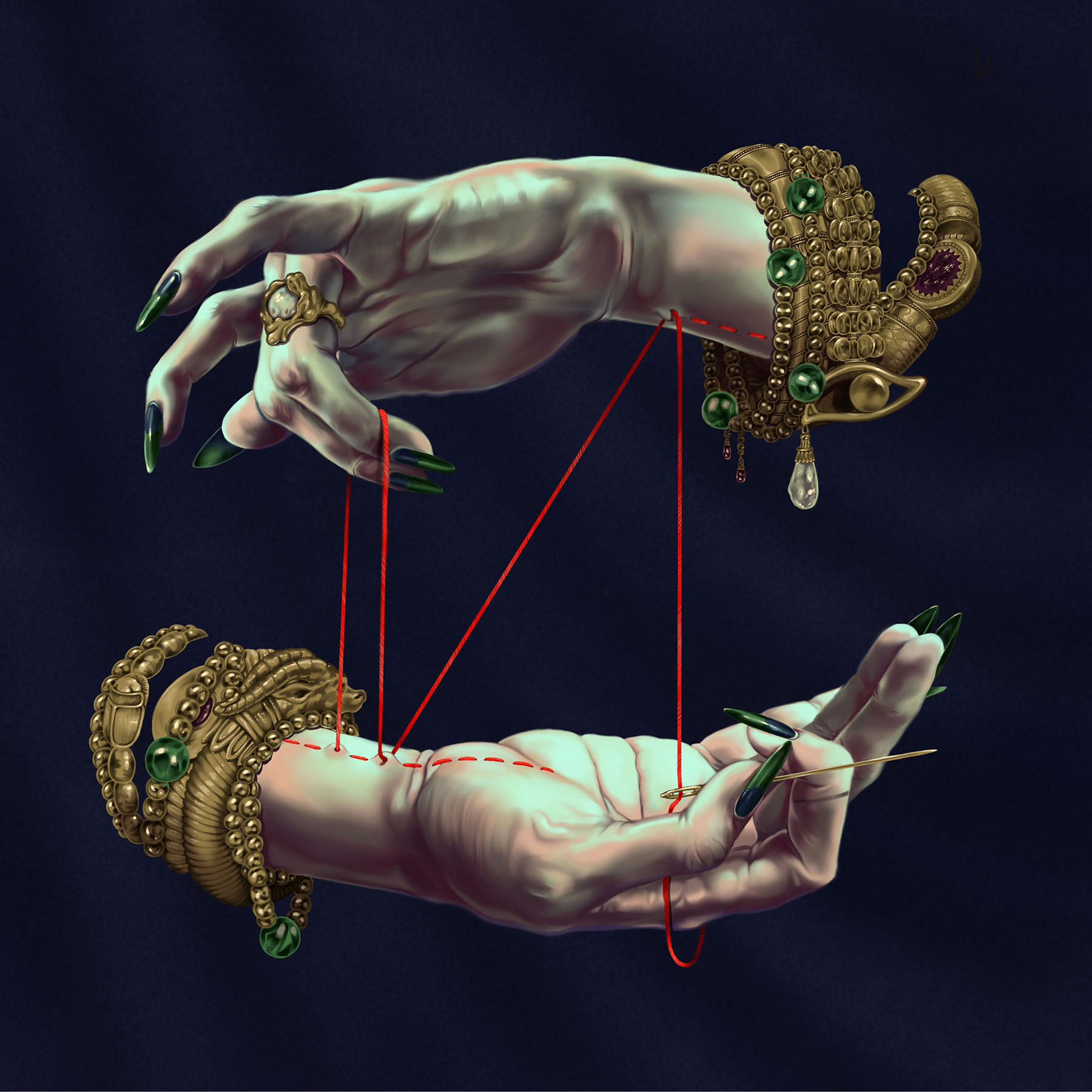
The image for Colin's book cover exercise
-
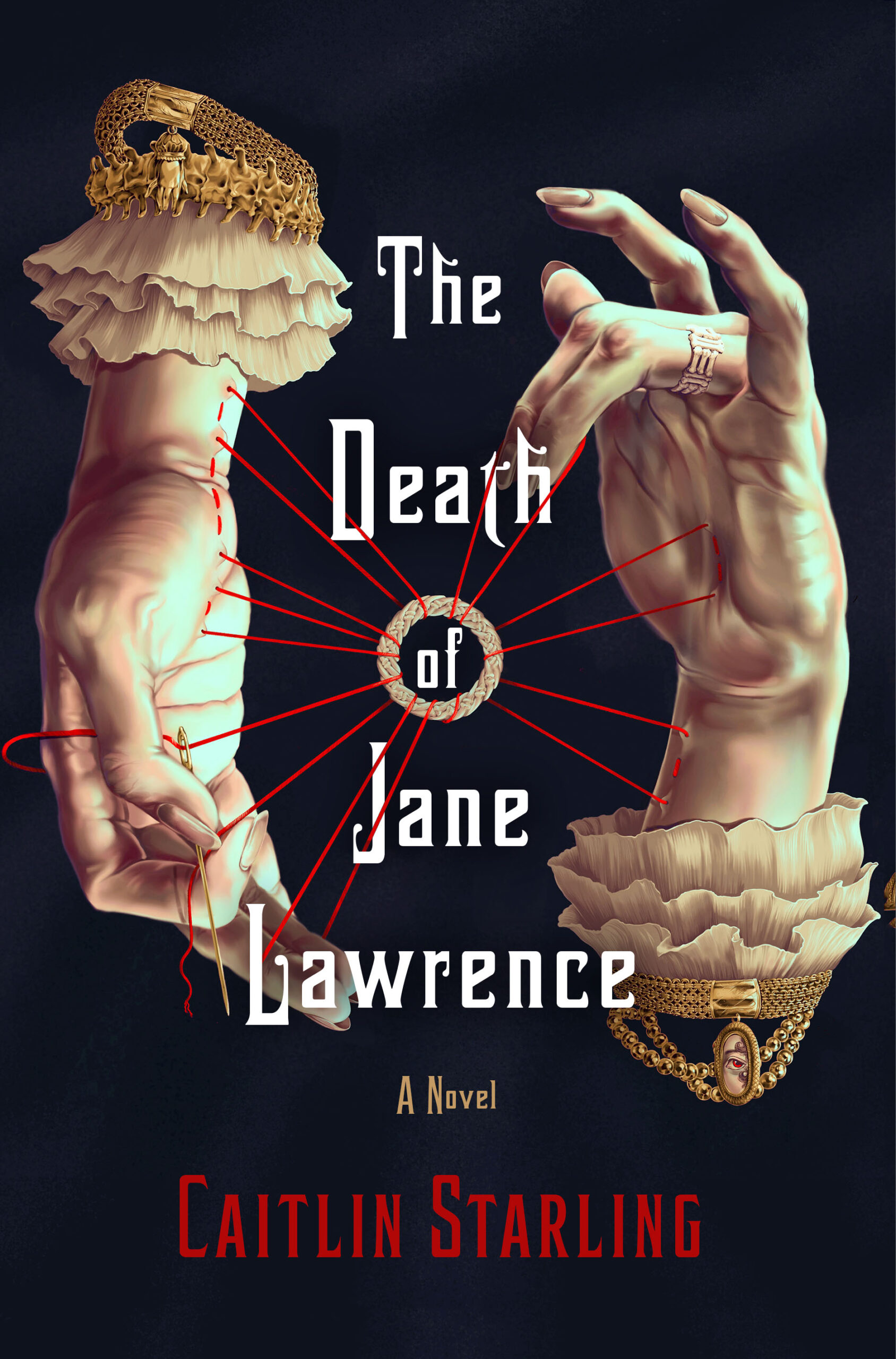
The final book cover
-
So where did things go from there?
Other art directors started to take notice of my work, I suppose they started thinking of me as someone who does books or could do books. I’m very grateful to Olga for being the person who took a chance on me in that space. That first book cover was in 2020. At this point, including the covers I’m working on right now, I’ve done over 30 to date
It’s amazing that you took the initiative to create a project for yourself, to aim for something you wanted.
I mean, it’s hard to tell people to do that because what you’re actually saying is, “Do work that you’re not being paid to do!” It took me a little while to grapple with that. I remember feeling like, “Well, I shouldn’t have to do this. They should be able to see how talented I am.”
When I first encountered your portfolio, I saw what I interpreted as an inherent queerness in your work. How does that resonate with you? How does queerness factor into your art?
I definitely think it does. Thank you for saying that. It’s hard to say how. Sometimes it feels very intentional and sometimes it doesn’t, but hopefully it shows up anyway? Having my art be seen as queer is important to me and I try to make time for projects that make that more explicit. I have a friend who hosts a drag show at the House of Yes, and I do the posters for them. I get paid a lot less to do that than a book cover, but I love it because they come to me with ideas that only other queer people would dream up. The work that I do with The InQueery has been similar in that regard. The concepts and the articles that you come to me with are freeing to work on.
-
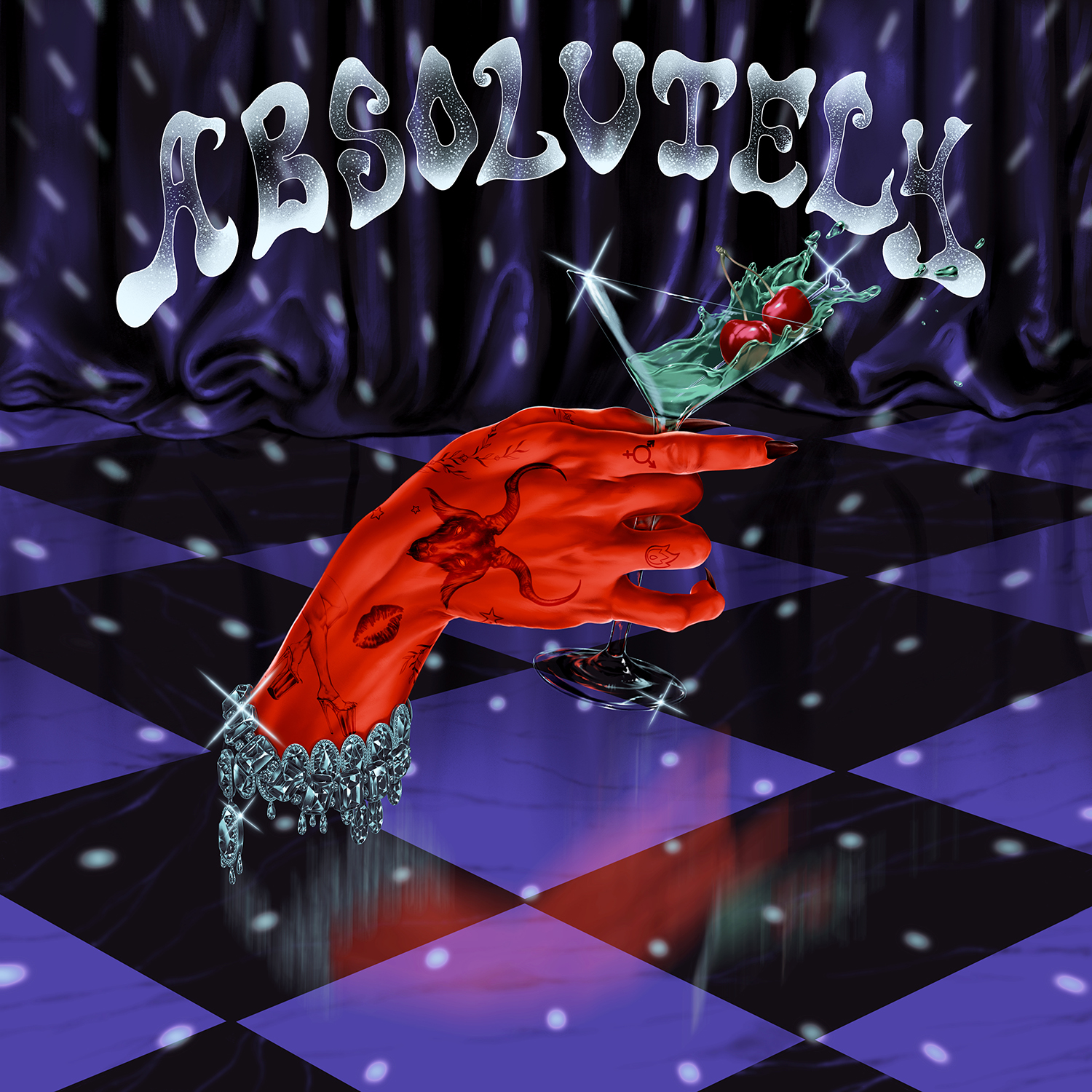
Poster for The House of Yes
-
Would you say that there’s a difference working on queer projects versus non-queer projects?
Sometimes art directors will relay buzzwords that are used to describe my work or why they’re choosing me. Words like grotesque, beautiful, dark, delicate, feminine, and often queer. That’s totally fine with me, and maybe half of the book covers that I have worked on have been about queer characters. A big part of that is because I know that authors fight for having queer artists do the cover of their book that they wrote about queer people. So even when it’s this corporatized project, it does feel somewhat similar to working on projects like The InQueery, because even though I don’t usually have a ton of contact with the authors, I know that there is this other queer artist on the other end who has spent a long time writing this story and has also had to go through the process of trying to share their story.
The perception of what is queer and what queer means to people is of course so varied. I feel like there’s a subcurrent or a visual language in your work that I perceive as queer.
I have worked on four book projects for the same author, Lev A.C. Rosen, and we’ve become friends, and recently we had a conversation about how it’s important to have a cover image that says “This is a queer book!” But it’s also complicated to package something like that, especially in the young adult genre, because not every kid is going to feel comfortable picking up that book and saying, “Mom, Dad, will you buy this for me?” In high school I had a friend who let me borrow her copy of Boy Meets Boy. I went to extreme lengths to hide it in my room so that no one would know that I had been reading a gay book. It’s probably still under a floorboard in there!
-
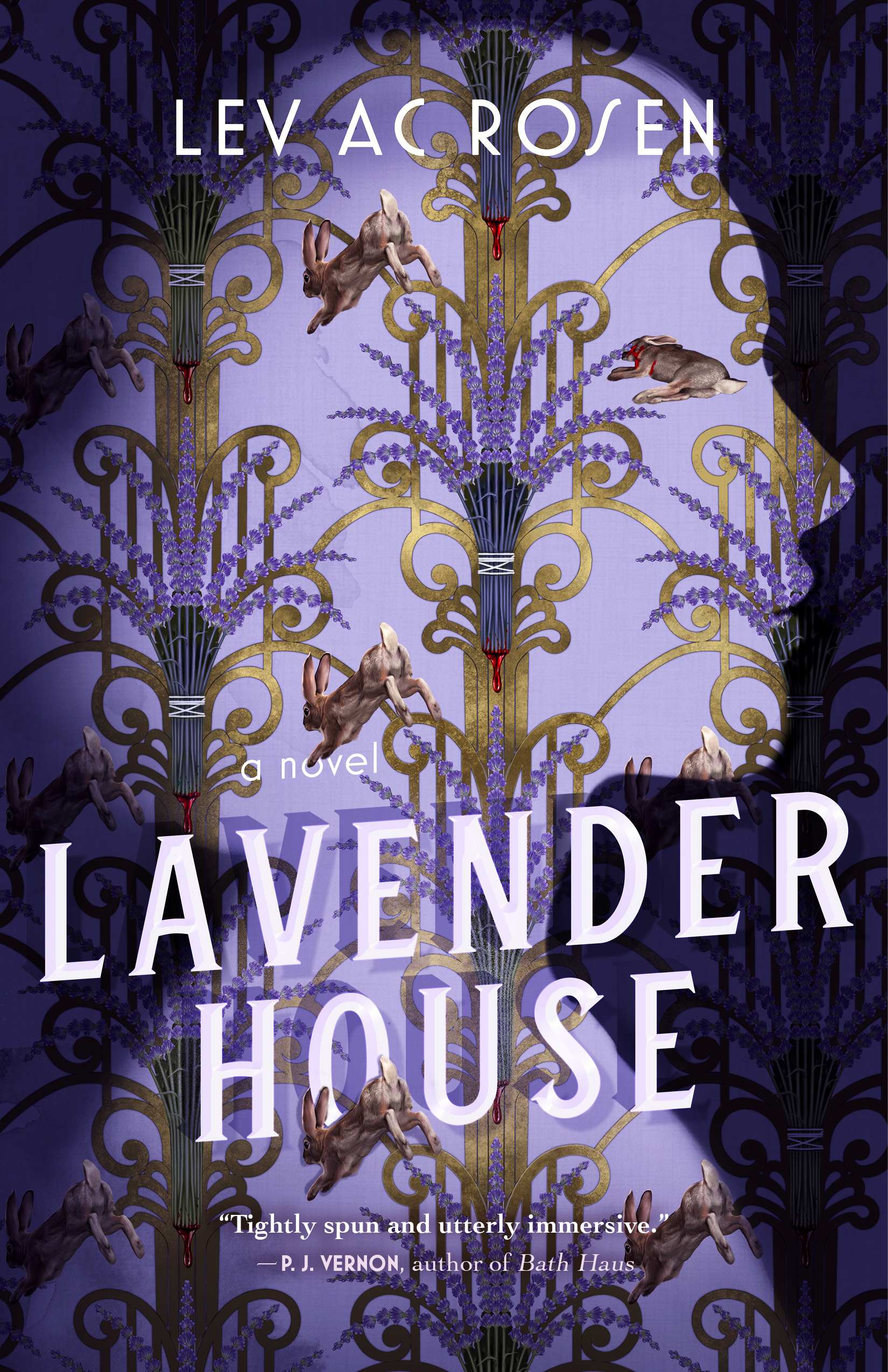
Cover illustration for the Lev AC Rosen book, Lavender House
-
We’ve been working together for four years, which has been such a pleasure. Looking back at your work over the last couple of years, how do you think you have grown as a creative person?
I used to have this impulse where I would have a kernel of an idea for an image and be excited to sit down and let loose. Now, because it’s my full time job, I do very little drawing outside of work. Most of the things that I’m working on involve decision making that doesn’t always feel intuitive. My technique has improved a lot, but when I’m thinking about future goals, I want to work on finding that elusive freedom again.
Looking toward the future, what are you keeping in mind for yourself?
I struggle with self doubt, which I think is fairly common. It’s funny because when I’m working, I’m the greatest artist who has ever lived. No one has ever done it like me. I am unstoppable. And then as soon as I step away and look at it, I’m like, “It’s dog shit. I can’t show anyone this!” One thing would be not fretting so much over making “good” work. I might not ever feel like my work is good, so I should try to focus more on feeling good when I’m making it. Often I’m thinking, “I don’t know why I’m doing this, but I like it.” So I’m grateful that I keep getting to do it!
-
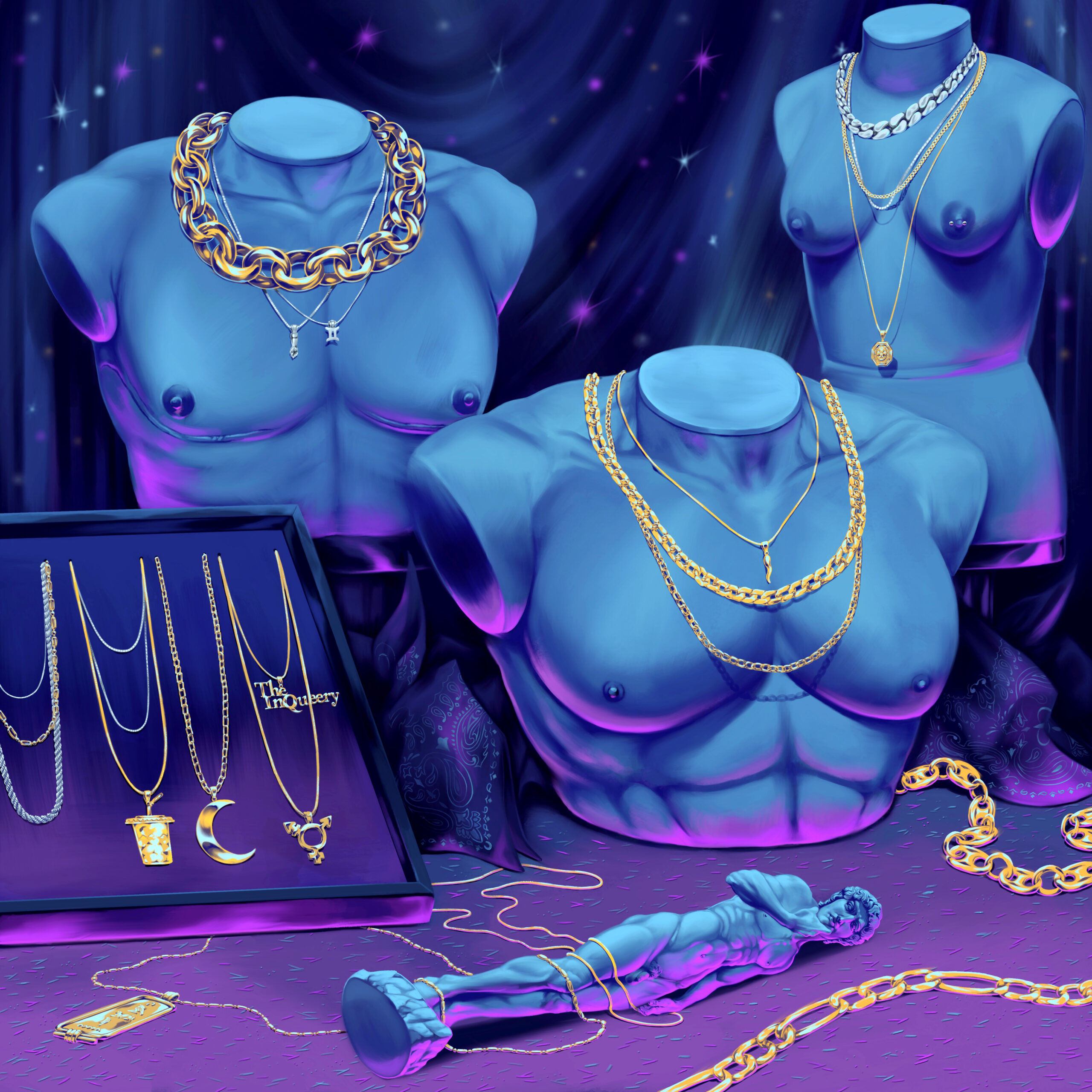
InQueery Illustration for The Chain Gayng
-
Are there kinds of projects you’d like to have the opportunity to do?
I’d love to do work for Magic the Gathering or something that’s more capital F fantasy. I think it would be so much fun! I had a lot of dorky interests as a young person that got bullied out of me by the time I was in college. Things I consider to be in “the nerd realm,” that for me, can also feel very “boy coded,” like video games and comic books and board games. When I first started making illustration work, I had this feeling that that stuff wasn’t cool, so I avoided it.
It’s interesting to hear you say boy coded. Do you feel like there was a fear or a rejection of gearing your work towards that?
Even at this moment I feel like I’m peeling back the layers of how I feel about this because I also think that there are all of these cringe feelings associated with owning one’s gamer-ness. I don’t want to sound like I think I’m better or cooler than anyone, because I’m certainly not, it’s just a complicated feeling. I’m just trying to let go of shame or fear in my creative impulses and like what I like.
When you’re a queer person and get bullied for your interests it makes sense that you would tuck them away and divorce yourself from them. Then at some point, it’s hard to reintegrate them into your creative and professional self.
Yes, totally. I feel like I see this with students who balk at the idea of having to send promo to art directors cold. With drawing or illustration or any creative pursuit, having to show people your work is scary. You are telling someone without words, this is what I was interested in enough to spend 20+ hours of my life doing.
I’m interested to know more about the process of your character design. When you’re drawing characters, where are they coming from?
The editorial work that I’ve done has been almost exclusively portraits. I’ve always been interested in portraits, even as a kid. Thanks to another SVA alumnus, A.E. Kieren, I am hired to work at events where I make live drawings or fashion illustrations of people on the spot. To me, it’s about being in a crowded room and picking someone out who is interesting and creating an impression of them. Even if I’m not aware of it, they must all be living in my head!
Sometimes I’ll do a sketch and think, I need a person here, and someone will come to mind. Either someone I know or someone I saw out in the wild.
So it took me a while to start getting jobs in that space, but my first “big,” published illustration jobs were in editorial. I do feel like having names like TIME Magazine on my website allowed book publishers to trust me to do covers though. I’m not in these rooms, so I’m making conjectures a bit, but it seems to me that art directors in publishing are beholden to a lot of other people, so when they’re bringing names to a pitch meeting, I think they want to know that they’re picking someone who has some professional illustration experience.
-
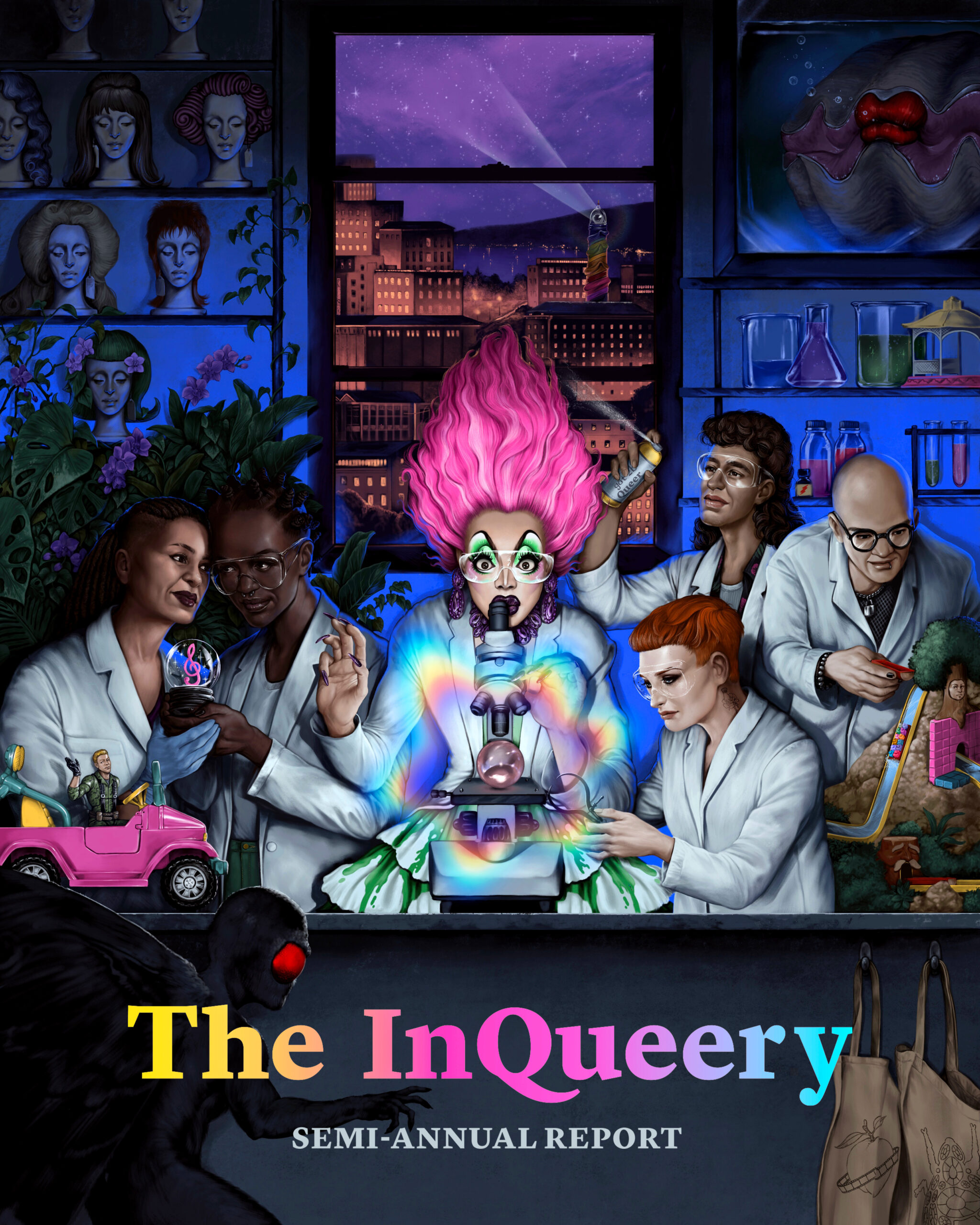
Cover illustraion for The InQueery Semi-Annual Report Volume II
-
Regarding the cover illustration you made for the second volume of The InQueery Semi-Annual Report, are there any references to people in your life?
One of them, I did not tell them I did this. I don’t want him to feel like I painted him into it, but that was who I imagined, I don’t know why, he just came to mind. And then there’s a woman named Crystal who I work with occasionally, she’s a muralist and fantastic artist. One of the researchers holding the snowglobe is based off of her. They don’t look like her, but to me they feel like her spiritually or something, I was channeling her. She’s straight but just feels so InQueery to me. She’s very into community building and art as community.
What about the drag queen scientist character?
She’s everyone! An amalgam of my favorite queens. I didn’t want it to feel like I just painted the Ru girl of the moment.
Is there anything else about this specific image that was important to mention or challenging for you?
I was cognizant of how this image needed to be chock full of Easter eggs and references for all of the articles in the issue. I kept going back and referencing the illustrations that other people made. It was an interesting challenge to make sure that I was keeping the spirit of something that someone else designed, but also not trying to not make it look out of place in my own illustration.
Your illustration ties a lot of artists’ work together in such a beautiful way, with your work at the forefront. Seeing references to work of The InQueery’s writers and illustrators feels like such a celebration of their creativity and represents the spirit of building a creative community. I think it’s a very challenging thing to do. It feels like you’ve woven together so many different elements in this beautiful tapestry. It’s one of the first times I’ve seen you illustrate a group scene.
I feel like it’s an element that’s been missing from my portfolio. I’ve been wanting to show that I have the ability to draw people interacting. I’m very grateful and happy with how it turned out and think it was what I needed. I will admit that when you said you wanted this concept, I was like, “Noooo that’s gonna be the hardest one!”
Any words of encouragement or otherwise for any queer, creative people out there?
Be patient and just keep doing your thing, which is really hard to hear. During the pandemic when all of my event work evaporated overnight, I was collecting unemployment and getting no illustration work. I would have been so frustrated to hear someone say just to keep trying, you know? But that’s the only thing that feels true for me, to stay the course and keep doing what I want to do. I’ve been lucky because I’ve been firm and clear about who I am and what I want to make, and slowly those things have found their way to me.
See more of Colin’s work.
-
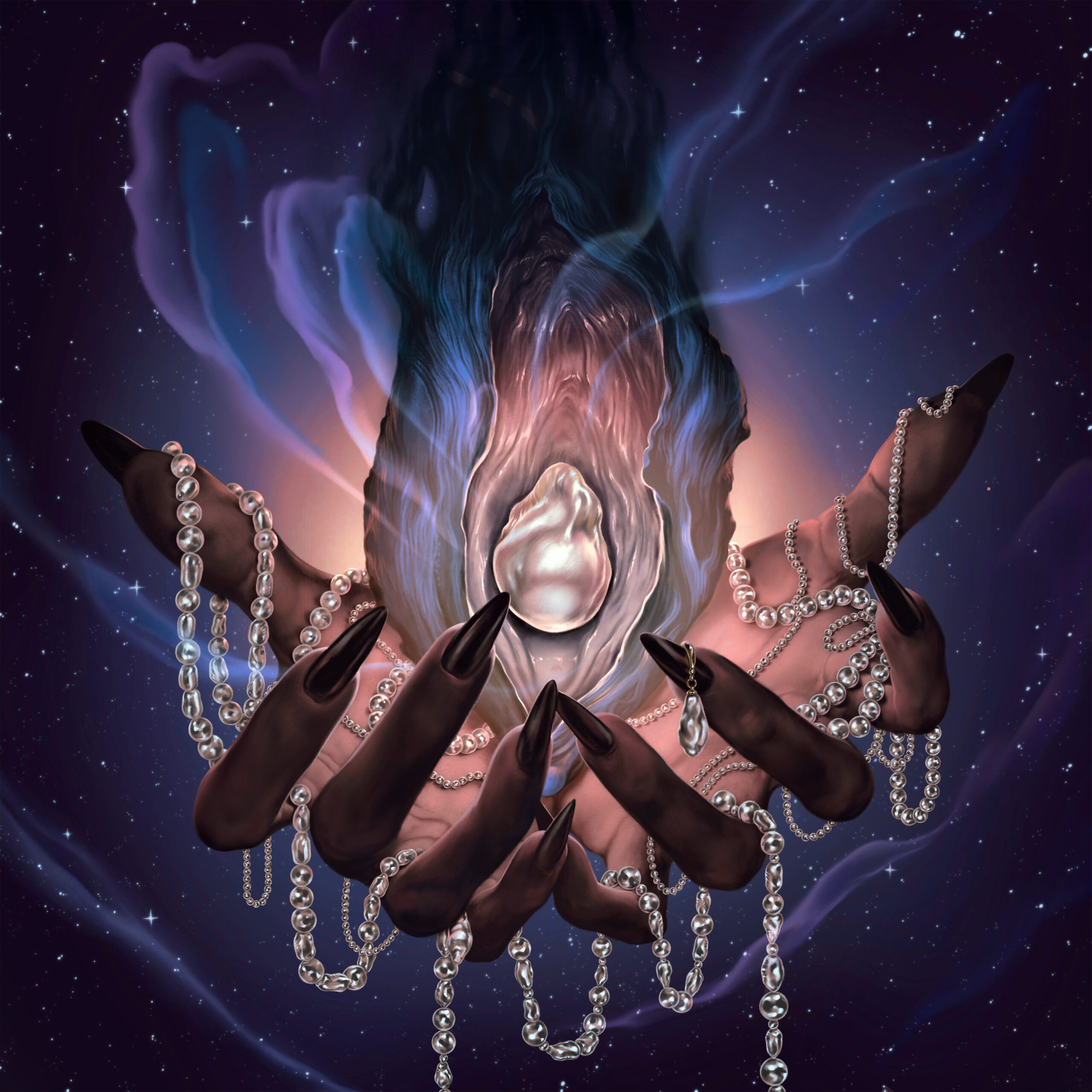
InQueery Illustration for Pearls Gone Wild
-
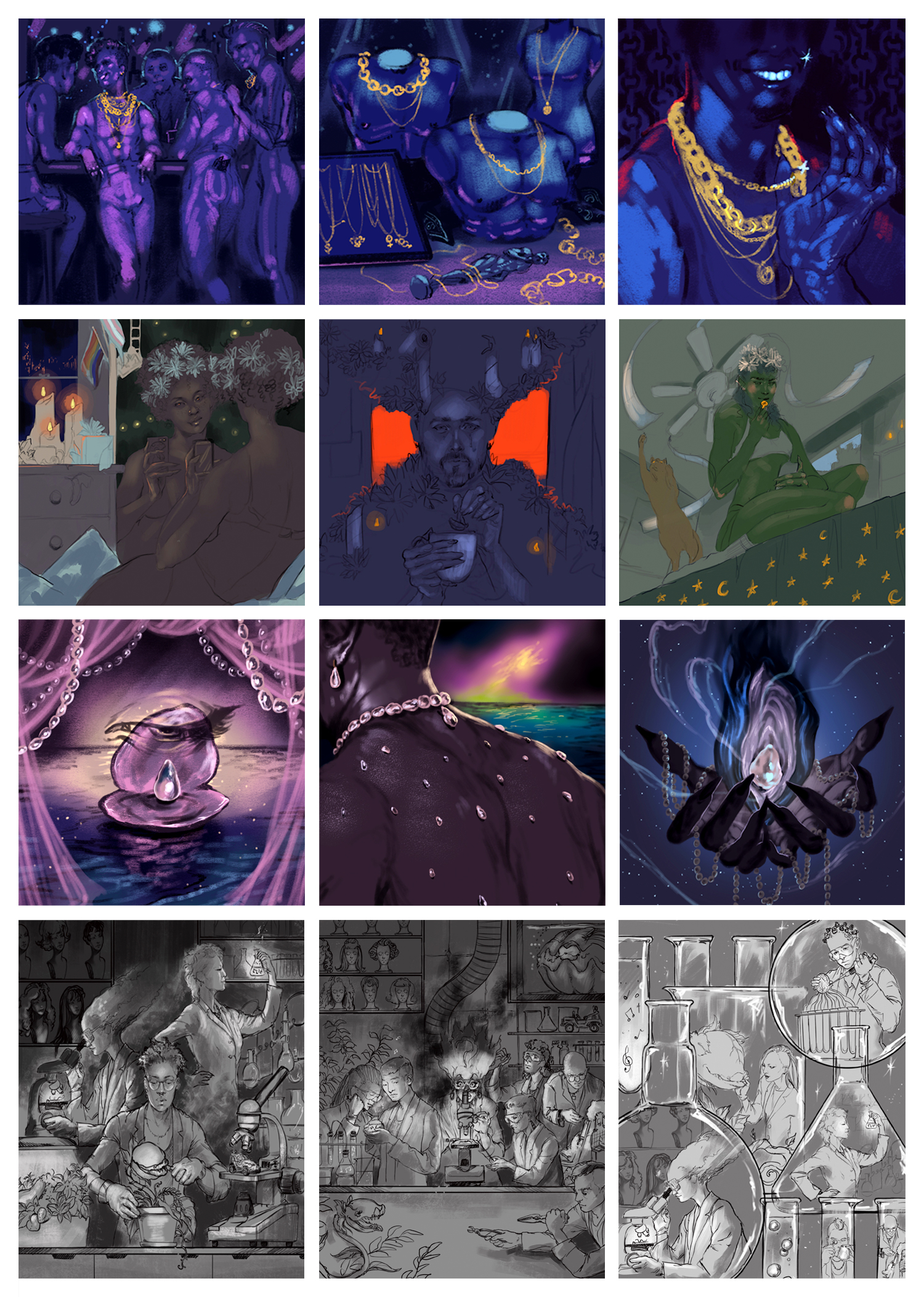
Colin's sketches for each InQueery illustration
Illustrator Spotlight:
Colin Verdi
filed July 15, 2023
Illustrator Spotlight:
Colin Verdi
filed July 15, 2023
-

2023 self portrait by Colin Verdi
Interview by Greg Kozatek
Copy edited by Nora MacLeod -
This interview has been edited for length and clarity.
What did you study as an undergrad?
My major was East Asian studies. I studied Chinese language and minored in business. I did the liberal arts undergrad thing because when I was 18, people in my life told me that pursuing art was a limiting decision, and that if I wanted to study art later, it would always be there. They said it would be harder to go to art school and then try to get a corporate job. Now, at 31, I don’t know if all those people were right, but at 18, I didn’t know any better, and it was scary.
Where did you go to grad school and what brought you there?
I went to the School of Visual Arts here in New York where I got my MFA in illustration. I graduated in 2018.
I don’t know what expectations I had. I’d done some small illustration-y jobs before getting a MFA, but I didn’t understand what I was getting myself into. I always liked to draw and was drawn to book covers and fantasy artwork and history paintings, specifically those centered around mythology. Growing up, my teachers would tell me, “This stuff that you’re making looks like illustration. You should look into that.” But the other adults in my life told me not to do art as a career because it’s “hard.” That’s all they ever said, “hard,” but I didn’t know what that meant
After undergrad, I spent a year applying to corporate jobs. At some point in every interview that I went on, the interviewer would look at me and say something like, “I just feel like you’d be happier doing something more creative,” and I wouldn’t get the job. I felt aimless and ashamed of failing in a very early-2010s-millenial-college-grad way, and that was already “hard,” so I decided to just give in to that impulse to pursue art as a career. One of my first illustration jobs was for Into the Gloss, because I had a friend who wrote for them and she was hired to write an article about Babeland, and she got me hired to tag along and make an illustrated map of the store to accompany the article. It was fun but I could already tell I had a lot to learn if I wanted to make it a “real” job. Funnily enough, later, when I was in grad school, I worked on the weekends at Babeland where I was a sex educator/sales associate. I was a pretty bad employee, spending half the time drawing during my shift, but after I graduated they hired me to produce illustrations that they could use as social media content. Some of my work ended up as banners in the store windows, which was one of my first experiences seeing my work out in the world in a different context. It was a full circle moment where Babeland was the subject of my first “real” paid illustration job, and then the first ones after grad school, too. Also, I loved that job and it felt rewarding to stay involved with the people there. Everyone that I worked with was queer and I felt solidarity with my coworkers.
-

Illustration for Babeland
-

Colin seeing his Babeland poster out in the world
-
Looking back do you feel as though illustration is a “hard” career path?
I think it’s hard in the way that it can be uneven. I feel very lucky that for the past two years work has been consistent, but it ebbs and flows. If you have a month where you’re not getting emails about new projects, it can feel like, “What am I gonna do?” It’s hard to switch off that part of your brain that panics.
Have you had months where nothing has come in?
Yes. But, it’s very “When it rains, it pours.” There’s maybe two months where I’m trying to juggle five projects and then a month where it’s crickets and I try to remind myself: “Two months from now you’re going to be overwhelmed, and you should take this time to rest and try to not let yourself get burnt out.”
Do you have advice for getting through the drier times?
I would say, save up more money than you think you need, because you might have to go three months where even if you’ve been doing work, you’re pestering someone to fulfill an overdue invoice from the last job. I think it’s just being sort of practical and living almost beneath your means a bit.
-

InQueery Illustration for Gay Day May Day
-
What kinds of projects are you most drawn towards?
Book covers suit me on a lot of different levels. The deadlines are generally longer than editorial, which is nice because my work is more painterly and takes time. Book projects also have a built-in narrative, which gives me more to play with than a page of text. And it’s so gratifying to see them out in the world, you’re basically making a tiny little billboard that would make someone scanning a shelf stop and say, “Ooh, that one!”
Starting off, were you getting different types of jobs?
When I was in grad school, they encouraged us to do editorial work so I started off trying to get that type of work, and I have done some. I learned how to make art quickly, but I don’t know how well my work is suited to editorial. I think a lot of the art directors are looking for work that is more conceptually driven. It’s not that I think I don’t have concepts or don’t think that I’m clever in the same way that editorial illustrators are, but I’m maybe more interested in execution, or something?
I’m curious to know more about your first book project.
I had it in my head that I wanted to work on books, but wasn’t getting any bites on my promotional emails. So I went to Barnes & Noble and took pictures of every book cover that made me have this feeling of, “I could have done that.” I went home and made a piece that I felt could sit alongside them, while still feeling like “me.” I sent that around and then maybe like six months after, an amazing art director at Macmillan, Olga Grlic, emailed me back and asked me to tailor it with some details for a book she was working on.
What was the name of the book?
The Death of Jane Lawrence. It’s a gothic horror in the same realm as Rebecca or Crimson Peak. When it came out, Barnes & Noble picked it for a monthly promotion and asked me if they could use the illustration on all of the signage featured in every one of their stores. They even agreed to print my name on the signs! That was very exciting, especially for the first “big” one, and it hasn’t happened again (yet).
-

The image for Colin's book cover exercise
-

The final book cover
-
So where did things go from there?
Other art directors started to take notice of my work, I suppose they started thinking of me as someone who does books or could do books. I’m very grateful to Olga for being the person who took a chance on me in that space. That first book cover was in 2020. At this point, including the covers I’m working on right now, I’ve done over 30 to date
It’s amazing that you took the initiative to create a project for yourself, to aim for something you wanted.
I mean, it’s hard to tell people to do that because what you’re actually saying is, “Do work that you’re not being paid to do!” It took me a little while to grapple with that. I remember feeling like, “Well, I shouldn’t have to do this. They should be able to see how talented I am.”
When I first encountered your portfolio, I saw what I interpreted as an inherent queerness in your work. How does that resonate with you? How does queerness factor into your art?
I definitely think it does. Thank you for saying that. It’s hard to say how. Sometimes it feels very intentional and sometimes it doesn’t, but hopefully it shows up anyway? Having my art be seen as queer is important to me and I try to make time for projects that make that more explicit. I have a friend who hosts a drag show at the House of Yes, and I do the posters for them. I get paid a lot less to do that than a book cover, but I love it because they come to me with ideas that only other queer people would dream up. The work that I do with The InQueery has been similar in that regard. The concepts and the articles that you come to me with are freeing to work on.
-

Poster for The House of Yes
-
Would you say that there’s a difference working on queer projects versus non-queer projects?
Sometimes art directors will relay buzzwords that are used to describe my work or why they’re choosing me. Words like grotesque, beautiful, dark, delicate, feminine, and often queer. That’s totally fine with me, and maybe half of the book covers that I have worked on have been about queer characters. A big part of that is because I know that authors fight for having queer artists do the cover of their book that they wrote about queer people. So even when it’s this corporatized project, it does feel somewhat similar to working on projects like The InQueery, because even though I don’t usually have a ton of contact with the authors, I know that there is this other queer artist on the other end who has spent a long time writing this story and has also had to go through the process of trying to share their story.
The perception of what is queer and what queer means to people is of course so varied. I feel like there’s a subcurrent or a visual language in your work that I perceive as queer.
I have worked on four book projects for the same author, Lev A.C. Rosen, and we’ve become friends, and recently we had a conversation about how it’s important to have a cover image that says “This is a queer book!” But it’s also complicated to package something like that, especially in the young adult genre, because not every kid is going to feel comfortable picking up that book and saying, “Mom, Dad, will you buy this for me?” In high school I had a friend who let me borrow her copy of Boy Meets Boy. I went to extreme lengths to hide it in my room so that no one would know that I had been reading a gay book. It’s probably still under a floorboard in there!
-

Cover illustration for the Lev AC Rosen book, Lavender House
-
We’ve been working together for four years, which has been such a pleasure. Looking back at your work over the last couple of years, how do you think you have grown as a creative person?
I used to have this impulse where I would have a kernel of an idea for an image and be excited to sit down and let loose. Now, because it’s my full time job, I do very little drawing outside of work. Most of the things that I’m working on involve decision making that doesn’t always feel intuitive. My technique has improved a lot, but when I’m thinking about future goals, I want to work on finding that elusive freedom again.
Looking toward the future, what are you keeping in mind for yourself?
I struggle with self doubt, which I think is fairly common. It’s funny because when I’m working, I’m the greatest artist who has ever lived. No one has ever done it like me. I am unstoppable. And then as soon as I step away and look at it, I’m like, “It’s dog shit. I can’t show anyone this!” One thing would be not fretting so much over making “good” work. I might not ever feel like my work is good, so I should try to focus more on feeling good when I’m making it. Often I’m thinking, “I don’t know why I’m doing this, but I like it.” So I’m grateful that I keep getting to do it!
-

InQueery Illustration for The Chain Gayng
-
Are there kinds of projects you’d like to have the opportunity to do?
I’d love to do work for Magic the Gathering or something that’s more capital F fantasy. I think it would be so much fun! I had a lot of dorky interests as a young person that got bullied out of me by the time I was in college. Things I consider to be in “the nerd realm,” that for me, can also feel very “boy coded,” like video games and comic books and board games. When I first started making illustration work, I had this feeling that that stuff wasn’t cool, so I avoided it.
It’s interesting to hear you say boy coded. Do you feel like there was a fear or a rejection of gearing your work towards that?
Even at this moment I feel like I’m peeling back the layers of how I feel about this because I also think that there are all of these cringe feelings associated with owning one’s gamer-ness. I don’t want to sound like I think I’m better or cooler than anyone, because I’m certainly not, it’s just a complicated feeling. I’m just trying to let go of shame or fear in my creative impulses and like what I like.
When you’re a queer person and get bullied for your interests it makes sense that you would tuck them away and divorce yourself from them. Then at some point, it’s hard to reintegrate them into your creative and professional self.
Yes, totally. I feel like I see this with students who balk at the idea of having to send promo to art directors cold. With drawing or illustration or any creative pursuit, having to show people your work is scary. You are telling someone without words, this is what I was interested in enough to spend 20+ hours of my life doing.
I’m interested to know more about the process of your character design. When you’re drawing characters, where are they coming from?
The editorial work that I’ve done has been almost exclusively portraits. I’ve always been interested in portraits, even as a kid. Thanks to another SVA alumnus, A.E. Kieren, I am hired to work at events where I make live drawings or fashion illustrations of people on the spot. To me, it’s about being in a crowded room and picking someone out who is interesting and creating an impression of them. Even if I’m not aware of it, they must all be living in my head!
Sometimes I’ll do a sketch and think, I need a person here, and someone will come to mind. Either someone I know or someone I saw out in the wild.
So it took me a while to start getting jobs in that space, but my first “big,” published illustration jobs were in editorial. I do feel like having names like TIME Magazine on my website allowed book publishers to trust me to do covers though. I’m not in these rooms, so I’m making conjectures a bit, but it seems to me that art directors in publishing are beholden to a lot of other people, so when they’re bringing names to a pitch meeting, I think they want to know that they’re picking someone who has some professional illustration experience.
-

Cover illustraion for The InQueery Semi-Annual Report Volume II
-
Regarding the cover illustration you made for the second volume of The InQueery Semi-Annual Report, are there any references to people in your life?
One of them, I did not tell them I did this. I don’t want him to feel like I painted him into it, but that was who I imagined, I don’t know why, he just came to mind. And then there’s a woman named Crystal who I work with occasionally, she’s a muralist and fantastic artist. One of the researchers holding the snowglobe is based off of her. They don’t look like her, but to me they feel like her spiritually or something, I was channeling her. She’s straight but just feels so InQueery to me. She’s very into community building and art as community.
What about the drag queen scientist character?
She’s everyone! An amalgam of my favorite queens. I didn’t want it to feel like I just painted the Ru girl of the moment.
Is there anything else about this specific image that was important to mention or challenging for you?
I was cognizant of how this image needed to be chock full of Easter eggs and references for all of the articles in the issue. I kept going back and referencing the illustrations that other people made. It was an interesting challenge to make sure that I was keeping the spirit of something that someone else designed, but also not trying to not make it look out of place in my own illustration.
Your illustration ties a lot of artists’ work together in such a beautiful way, with your work at the forefront. Seeing references to work of The InQueery’s writers and illustrators feels like such a celebration of their creativity and represents the spirit of building a creative community. I think it’s a very challenging thing to do. It feels like you’ve woven together so many different elements in this beautiful tapestry. It’s one of the first times I’ve seen you illustrate a group scene.
I feel like it’s an element that’s been missing from my portfolio. I’ve been wanting to show that I have the ability to draw people interacting. I’m very grateful and happy with how it turned out and think it was what I needed. I will admit that when you said you wanted this concept, I was like, “Noooo that’s gonna be the hardest one!”
Any words of encouragement or otherwise for any queer, creative people out there?
Be patient and just keep doing your thing, which is really hard to hear. During the pandemic when all of my event work evaporated overnight, I was collecting unemployment and getting no illustration work. I would have been so frustrated to hear someone say just to keep trying, you know? But that’s the only thing that feels true for me, to stay the course and keep doing what I want to do. I’ve been lucky because I’ve been firm and clear about who I am and what I want to make, and slowly those things have found their way to me.
See more of Colin’s work.
-

InQueery Illustration for Pearls Gone Wild
-

Colin's sketches for each InQueery illustration
